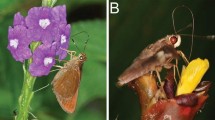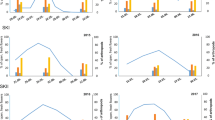Abstract
The butterfliesPapilio helenus andP. protenor were shown to feed mainly on the nectar of the glory bower,Clerodendron trichotomum, which was the most abundant nectar plant in summer in the study area. Both the species were found to have a proboscis longer than 24 mm corresponding to the length of the corolla tube ofC. trichotomum. Visits to the flowers by these butterflies were observed more frequently than visits by sphingid moths which had previously been believed to be the major pollinators ofC. trichotomum. The male butterflies visited trees ofC. trichotomum frequently, while visits by the females were less frequent. However, once females had visited the tree ofC. trichotomum, they remained there longer than the males. Since the flower ofC. trichotomum has long protruding sexual organs, its pollen grains were found to adhere efficiently to the bodies of butterflies, mainly the thorax, during nectar feeding. Most of the butterflies became loaded withC. trichotomum pollen, and the mean number of pollen grains per butterfly was 1,776 forP. helenus and 2,817 forP. protenor. The flowers opened at any time of day but more frequently in the morning. The nectar was secreted throughout the day. In the maturation of the protandrous flower ofC. trichotomum, the duration of the pistillate phase was about twice as long as the staminate phase. The long flowering period and the short duration of the staminate phase resulted in asynchrony of the flowering stages even within a single cyme on a tree. Such asynchrony and the abundance of attractive flowers on a tree facilitates efficient pollination by the butterflies.
Similar content being viewed by others
References
Beattie, A. J. (1971) A technique for the study of insect-borne pollen. The Pan-Pacific Entomologist47: 82.
Bell, G., Lefebvre, L., Giraldeau, L.-A. &Weary, D. (1984) Partial preference of insects for the male flowers of an annual herb. Oecologia64: 287–294.
Courtney, S. P. &Hill, C. J. (1983) Butterflies as pollinators: reply toTepedino. Oikos41: 145–146.
——,Courtney, S. P. &Hill, C. J. &Westerman, A. (1982) Pollen carried for long periods by butterflies. Oikos38: 260–263.
Cruden, R. W. &Hermann-Parker, S. M. (1979) Butterfly pollination ofCaesalpinia pulcherrima, with observations on a psychophilous syndrome. J. Ecol.67: 155–168.
Dobkin, D. S. (1984) Flowering patterns of long-livedHeliconia inflorescences: implications for visiting and resident nectarivores. Oecologia64: 245–254.
Faegri, K. & Pijl, van der L. (1966) The principles of pollination ecology. Pergamon Press, London.
Gilbert, L. E. (1972) Pollen feeding and reproductive biology ofHeliconius butterflies. Proc. Nat. Acad. Sci.69: 1403–1407.
Jennersten, O. (1984) Flower visitation and pollination efficiency of some North European butterflies. Oecologia63: 80–89.
Kiritani, K., Nozato, K., Miyai, S. &Ban, Y. (1984) Studies on ecology and behavior of Japanese black swallowtail butterflies I. Ecological characteristics of male populations inPapilio helenus nicconicolens Butler andP. protenor demetrius Cramer (Lepidoptera; Papillionidae). Appl. Ent. Zool.19: 509–517.
Levin, D. A. &Berube, D. E. (1972)Phlox andColias: The efficiency of a pollination system. Evolution26: 242–250.
Murphy, D. D. (1984) Butterflies and their nectar plants: the role of the checkerspot butterflyEuphydr yas editha as a pollen vector. Oikos43: 113–117.
Suzuki, N., Niizuma, A., Yamashita, K., Watanabe, M., Nozato, K., Ishida, A., Kiritani, K. &Miyai, S. (1985) Studies on ecology and behavior of Japanese black swallowtail butterflieds. 2. Daily activity patterns and thermoregulation in summer generations ofPapilio helenus nicconicolens Butler andP. protenor demetrius Cramer (Lepidoptera: Papilionidae). Jap. J. Ecol.35: 21–30.
Tanaka, H. (1973) Moth pollination ofClerodendron trichotomum. Journ. Jap. Bot.48: 209–214 (In Japanese with English summary).
Tepedino, V. J. (1983) Pollen carried for long periods by butterflies: some comments. Oikos41: 144–145.
Waser, N. M. (1982) A comparison of distances flown by different visitors to flowers of the same species. Oecologia55: 251–257.
Watt, W. B., Hoch, P. C. &Mills, S. G. (1974) Nector resource use byColias butterflies—Chemical and visual aspects. Oecologia14: 353–374.
Wiklund, C. (1977) Oviposition, feeding and spatial separation of breeding and foraging habitats in a population ofLeptidea sinapis (Lepidoptera). Oikos28: 56–68.
—,Eriksson, T. &Lundberg, H. (1979) The wood white butterflyLeptidea sinapis and its nectar plants: a case of mutualism or parasitism? Oikos33: 358–362.
——— (1982) On the pollination efficiency of butterflies: a reply to Courtney. Oikos38: 263.
Author information
Authors and Affiliations
About this article
Cite this article
Suzuki, N., Yamashita, K., Niizuma, A. et al. Studies on ecology and behavior of Japanese black swallowtail butterflies. 6. Nectar feeding ofPapilio helenus nicconicolens Butler andP. protenor demetrius Cramer as main pollinators of glory bower,Clerodendron trichotomum, Thunb. Ecol. Res. 2, 41–52 (1987). https://doi.org/10.1007/BF02348618
Accepted:
Issue Date:
DOI: https://doi.org/10.1007/BF02348618




